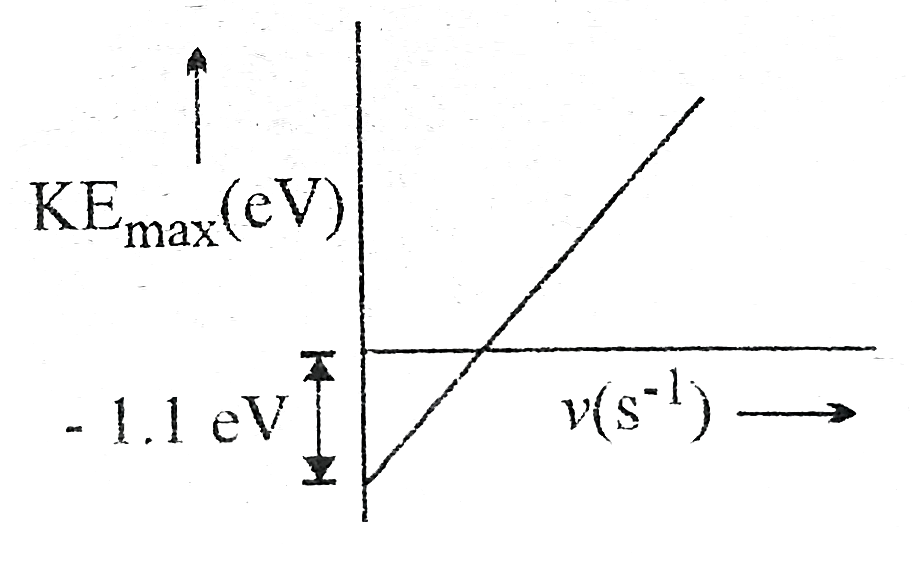light of frequrency 7.5×1014 Hz is incident on a metal surface . A curve between KEmaxv/s incident frequency is plotted as shown .Find
(a) Thee stopping potential
(b) Magnitude of the slope of curve given
(C ) Intercept on x-axis

KEmax=hv−hv0 ….(1)
hv0=1.1eV (from the given curve given )
Incident energy =hv
=6.62×10−34×7.5×10−14J ⇒6.62×10−20×7.51.6×10−19eV ⇒3.1eV
KEmax=3.1−1.1=2eV
we know that
(a) stopping potential =KEmax/e
=2V
magnitude of slope of curve =h
6.62×10−34Js1.6×10−19⇒4.14×10−15
(c)Intercept on x-axis =Threshold frequency
v0=1.1eVheV−s=1.14.14×10−15=2.66×1014Hz
Topper's Solved these Questions
- ATOMIC STRUCTUREBook:BANSALChapter:ATOMIC STRUCTUREExercise:Exercise
Explore 12 Videos
- ATOMIC STRUCTUREBook:BANSALChapter:ATOMIC STRUCTUREExercise:Exercise.1
Explore 48 Videos
- ATOMIC STRUCTUREBook:BANSALChapter:ATOMIC STRUCTUREExercise:Exercise.3
Explore 35 Videos
- GENERAL ORGANIC CHEMISTRYBook:BANSALChapter:GENERAL ORGANIC CHEMISTRYExercise:Exercise 3
Explore 9 Videos
Similar Questions
A photon of frequency 5×1014Hz is incident on the surface of a metal. What is the energy of the incident photon in eV?
View SolutionThe work function of cesium metal is 2.14 eV .When light of frequency 6×1014 Hz is incident on the metal surface.phtoemission of electrons occurs. What is the :
(a) maximum kinetic energy of the emitted electrons,
(b) stopping potential , and
(c) maximum speed of the emitted photo - electrons ?
View Solution
Knowledge Check
Work function of potassium metal is 2.30 eV . When light of frequency 8×1014 Hz is incident on the metal surface, photoemission of electrons occurs. The stopping potential of the electrons will be equal to
A0.1 VB1.0 VC2.3 VD3.3 VA light is incidence on a metallic surface. Graph etween stopping potential Vs and 1λ is as shown in figure. when intensity of ligh is increases at given frequency then:
 AGraph does not changeBGraph steeperCVs intercept changeDGraph gets narrower
AGraph does not changeBGraph steeperCVs intercept changeDGraph gets narrower
The work function of caesium is 2.14 eV. When light of frequency 6×1014Hz is incident on the metal surface, photoemission of electrons occurs. What is the (a) maximum kinetic energy of the emitted electrons. (b) stopping potential and (c) maximum speed of the emitted photoelectrons. given , h=6.63×10−34Js,1eV=1.6×10−19J,c=3×108m/s.
View SolutionThe work function of caesium metal is 2.14 eV. When light of frequency 6×1014Hz is incidennt on the metal surface, photoemission of electrons occus. What is the
(a) maximum kinetic energy of the emitted electrons,
(b) stopping potential, and
(c) maximum speed of the emitted photoelectrons ?
View SolutionA photon of frequency 5×1014Hz is incident on the surface of a metal. If the photoelectric thresh-old frequency for the metal is 3×1014Hz, Calculate the following
Energy of the photon
View SolutionLight of frequency 7.21×1014Hz is incident on a metal surface. Electrons with a maximum speed of 6.0×105m/s are ejected from the surface. What is the threshold frequency for photoemission of electrons ?
View SolutionWork function of potassium metal is 2.30 eV . When light of frequency 8×1014 Hz is incident on the metal surface, photoemission of electrons occurs. The stopping potential of the electrons will be equal to
View SolutionA photon of frequency 5×1014Hz is incident on the surface of a metal. If the photoelectric thresh-old frequency for the metal is 3×1014Hz, Calculate the following
Photoelectric work function in eV
View Solution

